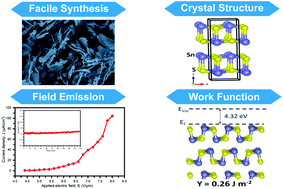An interlinked computational–experimental investigation into SnS nanoflakes for field emission applications
Abstract
Layered binary semiconductor materials have attracted significant interest as field emitters due to their low work function, mechanical stability, and high thermal, and electrical conductivity. Herein, we report a systematic experimental and theoretical investigation of SnS nanoflakes synthesized using a simple, low-cost, and non-toxic hot injection method for field emission studies. The field emission studies were carried out on SnS nanoflake thin films prepared using a simple spin coating technique. The X-ray diffraction (XRD) and Raman spectroscopy analysis revealed an orthorhombic phase of SnS. Scanning electron microscopy (SEM) analysis revealed that as-synthesized SnS has a flakes like morphology. The formation of pure-phase SnS nanoflakes was further confirmed by X-ray photoelectron spectroscopy (XPS) analysis. The UV-Visible-NIR spectroscopy analysis shows that SnS nanoflakes have a sharp absorption edge observed in the UV region and have a band gap of ∼1.66 eV. In addition, the first-principles density functional theory (DFT) calculations were carried out to provide atomic-level insights into the crystal structure, band structure, and density of states (DOS) of SnS nanoflakes. The field emission properties of SnS nanoflakes were also investigated and it was found that SnS nanoflakes have a low turn-on field (∼6.2 V μm−1 for 10 μA cm−2), high emission current density (∼104 μA cm−2 at 8.0 V μm−1), superior current stability (∼1 μA for ∼2.5 hrs), and a high field enhancement factor of 1735. First principles calculations predicted lower work function for different surfaces, especially for the most stable SnS (001) surface (ϕ = 4.32 eV), which is believed to be responsible for the observed facile electron emission characteristics. We anticipate that the SnS could be utilized for future vacuum nano/microelectronic and flat panel display applications due to the low turn-on field and flakes like structure.



 Please wait while we load your content...
Please wait while we load your content...